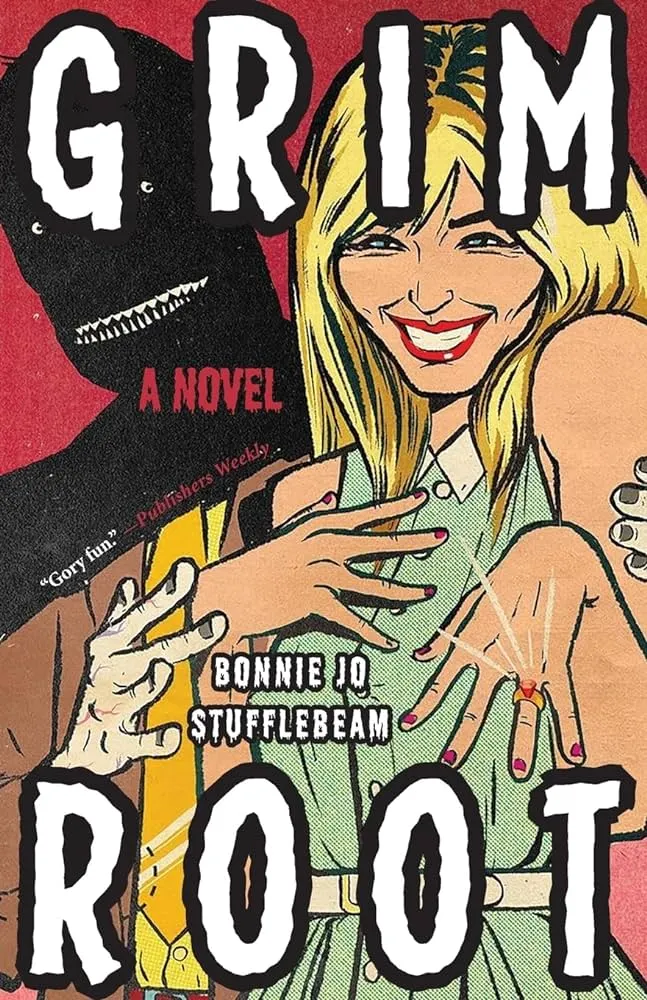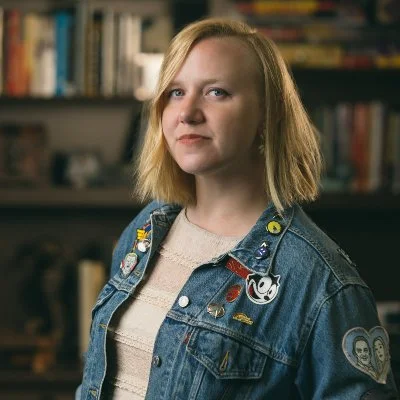
An Interview with Bonnie Jo Stufflebeam
Words By Words By Bonnie Jo Stufflebeam, Interview by Dominic Loise
It wasn’t the haunted house in your book, Grim Root, that I found triggering but what TV producer, Deja, puts contestants through on the novel’s reality TV show, The Groom. Can you talk about how you researched the behind-the-scenes practices of reality TV for the book?
I read some behind-the-scenes memoirs, like Amy Kaufman’s Bachelor Nation, but I also follow the reality TV news—and one of my major inspirations was the fictional show UnREAL. I also read a fair number of articles on the psychology of reality TV, how close quarters increased pressure, isolation from the outside world, etc., lead to a heightening of emotions. I’m fascinated by that side of the genre.
At one point, a someone in production admits reality TV is “…engineered that way. They work with psychologists, you know, to create the perfect conditions to evoke limerence. Isolation. Shared fear.” How does Grim Root twist this concept of “shared fear” for a horror novel?
Reality TV, like good fiction—in this case, horror fiction—is all about tension. As a writer, you treat your characters like kings in a chess game, increasing the threat from as many angles as possible, moving in until they’re backed into corners and forced to make big, blow-up decisions. Reality TV producers do the same thing to their characters; the difference is that those characters happen to be real people.
I’ve just upped the stakes for the reality TV element, making it literal life and death.
In particular, Linda’s character is manipulated by Deja in multiple ways. Would you explain the concept of the “villain cut” in reality TV and how Deja uses that with Linda?
Good stories require antagonists, and that’s something reality TV has taken into account. A reality TV villain is usually a big personality, maybe someone who is combative, and who the producers decide will make a good “villain.” They then cut the show to make it even easier to view that person as the major antagonist of the show. There might be parts they cut where the antagonist explains their decisions, etc., to make them look as over the top as possible. It’s a known reality TV trope, and contestant contracts often state editorial can cut the footage however they want.
Deja threatens Linda with a villain cut, using Linda’s past against her. Since Linda wants to come off as a good person, Deja tries to control Linda with this threat.
Can you talk about the cycle of manipulation the contestants faced from their past relationships and how it is taken advantage of for entertainment? How are their pasts being woven into their storylines by production?
Both Sabrina and Linda have been manipulated by family, and that’s something the producers use to provoke certain responses from them on the show. Both main characters have a fierce desire to be accepted and loved, and the producers promise that: from the Groom, and from the audience. Then they use that desire to make them do the things they want them to do on camera.
Fashion and a lavish mansion are a big part of reality TV shows, yet you included the poignant line, “Skeletons lived in bodies, not closets” regarding someone’s past. Given this is also a haunted house story, could you talk about how the location of Matrimony Manor, where the show is filmed, is also a character with its own secrets?
Like any good haunted house story, Matrimony Manor’s own past directly affects the characters; the horror is linked to the house itself. The interplay between the house’s secrets and the character’s secrets runs parallel and reveals itself throughout the book.

Due to editing and manipulation tactics, we can’t trust the reality of these tv shows. How do the characters face their own instances of manipulation before they get to the taping of the show?
We’re all affected by our trauma, personal and generational, so Sabrina and Linda are no exception. Sabrina has been manipulated by her mom, then her sister, to believe her main goal in life should be to marry rich, when she’s always desired to prioritize her medical career. Linda, on the other hand, fought back against her own manipulations—and has paid the price. The show casts her as the tarnished divorcee, a ruined woman—and even if she doesn’t believe that, and she’s forced to pretend at that role in order to hide the things she did as a little girl.
What do you feel the appeal of reality television is for a viewer?
Reality TV relies on tropes and larger-than-life characters, as well as fantasy. Genre fiction, particularly romance and horror, also utilizes tropes—pulling people in with the familiar, then twisting those tropes to provide excitement and novelty. It’s a winning formula, and when it’s combined with this idea that the people on these shows are just like us, that we could even be one of them if we wanted, that proves seductive. I also believe the “theatrical versus reality” aspect of it is appealing, like wrestling. The curiosity of it being fake-but-not-fake, of being a fan in on the game. I admit, I watch reality TV dating shows. They intrigue me as much as they intrigue the rest of their audience base.
Grim Root holds a mirror up to a cultural phenomenon. What other horror was an inspiration for this social commentary?
Shirley Jackson was a huge influence, particularly Haunting of Hill House. I’ve also been writing stories with morally grey women characters ever since I read In the House in the Dark of the Woods by Laird Hunt. The twist comes toward the very end of the novel, where we learn an important detail about the main character’s past, which changes our view of her. Additionally, I’ve been inspired by the romance genre and the things it shares in common with horror. Marrying the two was a goal with this book.
Where can our readers find you online and check out more of your work?
I have everything I’ve ever published linked on my website, www.bonniejostufflebeam.com—and I’m still occasionally on Twitter and Instagram, though you won’t see me posting all that much